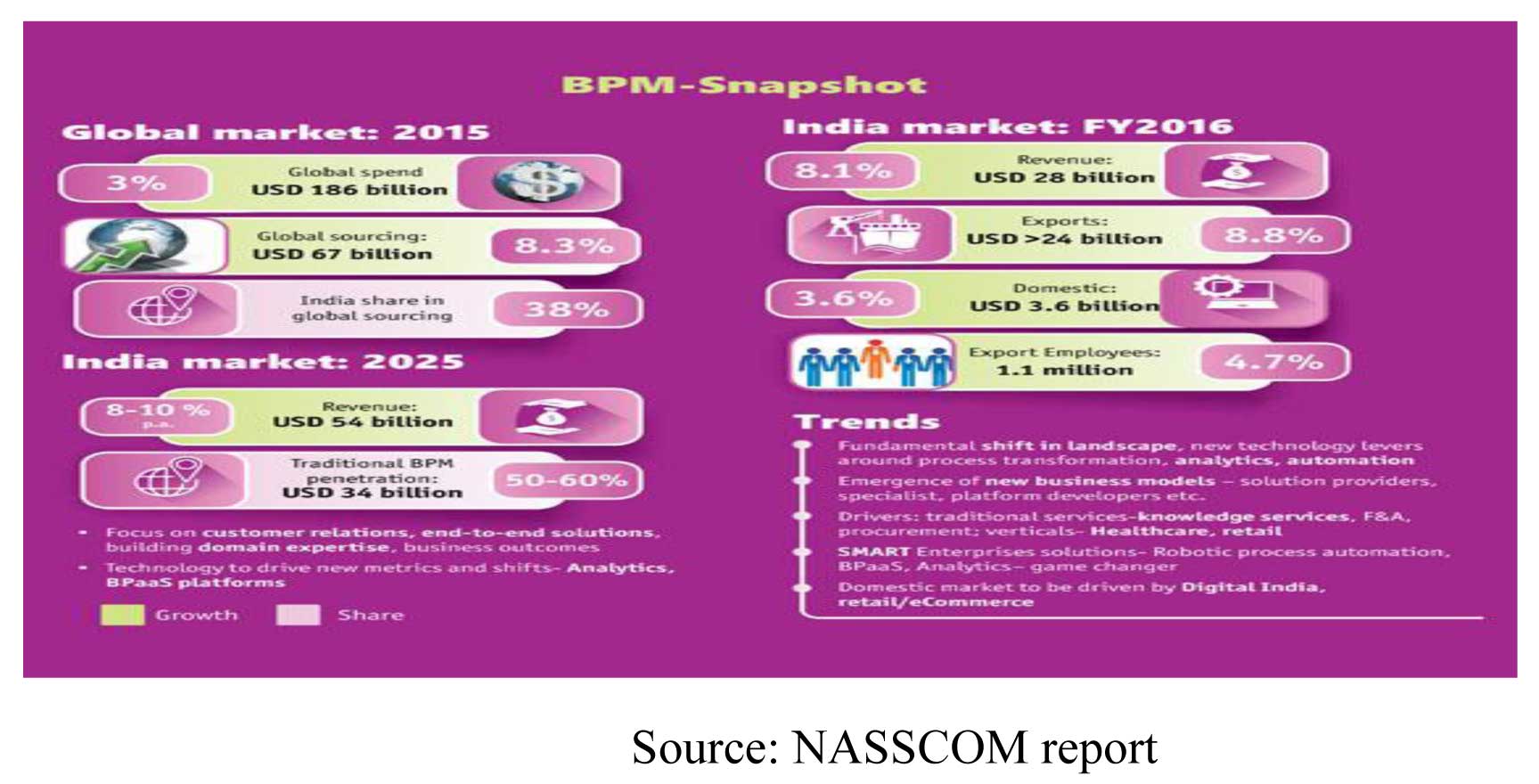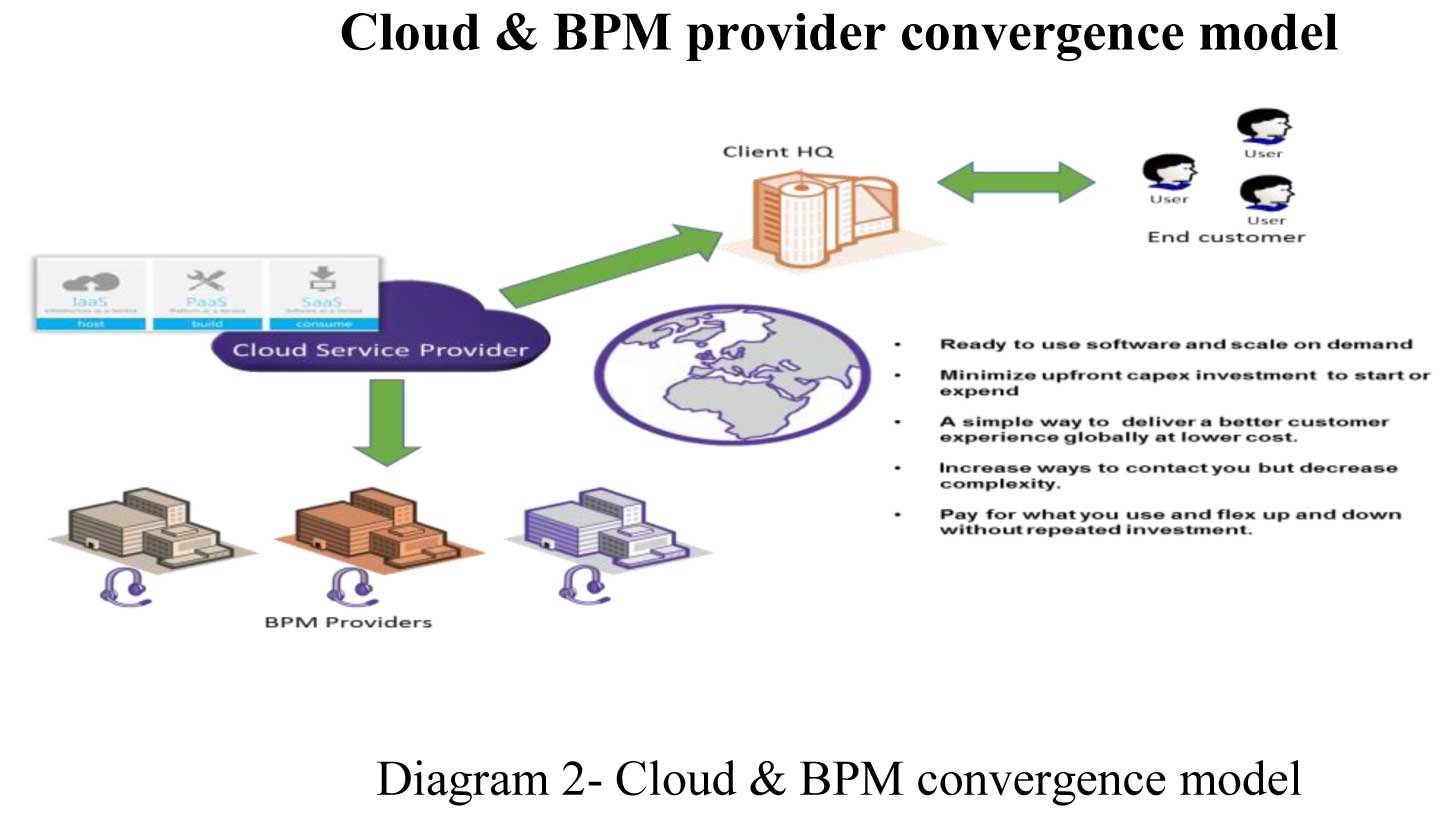Subscribe now to get notified about IU Jharkhand journal updates!
From BPO To BPM Industry In India – The Importance Of Cloud Technologies
Abstract :
Over last two decades, we have seen tremendous growth in BPO (Business Process Outsourcing) sector in India and it’s the fastest growing sector of Indian ITeS industry currently valued at US$ 28 billion and expected to touch US$ 54 billion by 2025as per NASSCOM report. Since its inception in mid-90s from providing Call Centre & Process Outsourcing services, it has transformed itself to provide higher end services by moving up in value chain to address the dynamic and changing demand of market and develop as the global hub for end to end service outsourcing activities. By looking the success story of the Indian outsourcing Industry led several countries across the world to emulate the BPO industry growth model. Countries like Philippines successfully replicated the Indian success story and already started giving tough competition to Indian BPO companies in the global sphere specially for Voice based call centre services Foreseeing the future beforehand, some of the large BPO players in India started building their service capabilities according to the new business dynamics and client expectations to switch the model from vendor to partner for business growth. Therefore, NASSCOM (National Association of Software Services and Companies), the industry body representing IT & ITES companies in India rebranded the industry from Business Processing Outsourcing to Business Process Management (BPM). The objective of this re-branding exercise isto provide the Indian outsourcing companies the much needed identity of end-to-end Business Process services providers that not only handle transactions but also provide business processes expertise. Indian government have initiated IBPS under Digital India Programme, to setup BPO operations in smaller town across the country and incentivize them. In the journey to transform from BPO to BPM provider, Cloud services have crucial area to play by revolutionize the way outsource service provider extend their offering and the benefits to the clients, with the Cloud driving the delivery engine, BPM providers can move to a higher level of efficiency & economic model by leveraging the cloud capabilities to reduce cost, enhance scalability, greater agility and high reliability, however the questions around data security & integrity are still major concerns from the client in this area, which can be mitigated by choosing the Cloud vendor carefully and having security governance in place. This article looks the importance of Cloud services in the transformation journey of outsourcing industry in India from BPO to BPM.
Keywords :
Business Process Outsourcing (BPO), Business Process Management (BPM), National Association of Software Services and Companies (NASSCOM), Information Technology & Information Technology Enabled Services (IT & ITeS), Outsourcing, India BPO Promotion Scheme (IBPS), Platform As A Service (PaaS), Software As A Service (SaaS), Infrastructure As A Service (IaaS)INTRODUCTION
Business Process Management (BPM) providers deliver end-to-end Business Process services that not just handle transactions but also provide business processes expertise, typically spanning five stages: design, modelling, execution, monitoring and optimisation. Whereas, Business Process Outsourcing (BPO) as it is popularly known, refers to outsourcing of the business processes. A BPO service provider usually administers and manages a particular business process for another company.
The Information technology and IT-enabled services industry continue to be the key enabler in the growth and development of Indian economy, the industry also bringing significant employment in India in addition of revenue growth.BPM is the fastest growing segment of the ITES (Information Technology Enabled Services) industry in India and has been widely considered as the centre hub for its global BPM industry. Below is snapshot of BPM market prospect in India,

The BPM industry in India has transformed significantly over the past few years by gaining experience, maturity, and focusing towards higher-end services and global competitiveness. Today, the industry has a more business oriented and intellectual role to play, the re-branding from BPO to BPM was primarily deliberated to lift the negative image of the BPO industry from providing back-office process support and English speaking skills only for taking calls to make the organisation’s workflow more effective, more efficient and agile to dynamic changes of business demand.
The industry has matured to offer 360-degree services - consulting, specialisation, business process transformation and that have resulted to influence clients with end to end services proposition.

Design :
This stage comprises of identifying the existing process and “to be” Processes with consulting engagement to do the gap analysis and drive the design based on business outcome. The existing process and the design of new process for various applications will have to synchronise and not impact the services.
Modelling :
In this stage, the theoretical design is tested to develop as blue print and introduces combinations of variables to assess how the things will operate in reality on testing bed
Execution :
After modelling stage is over with expected results then its turn for implementing the model in operations, one of the ways to automate processes is to develop or purchase a software applicationthat executes the required steps of the process or sometime the execution is carried with the combination of software & human intervention.
Monitoring :
Monitoring stage comprises of tracking the implemented process and provide the performance reports on these processes.
Optimisation :
After the business processes are stabilised and matured, it’s the time to explore opportunities for optimisation or cost transformation under this stage.
Key trends, which will drive BPM value propositions,
BPAAS Model
The rise of BPAAS (Business Process as a Service) will transform the way BPM provider deliver the services to their clients globally as it’s based on cloud computing service and allow utility based consumption of services.
Business process automation (BPA)
One of the key enabler of BPM provider is to bring business process automation in offering end to end management of business process is by bring automation and provide round-the-clock support which ensures customer support SLA are met, through a systematic workflow. The objective of BPA is to not only automate business process, but to simplify the business workflows also.
Up in value chain and Reducing TAT
To move up into the value chain, BPM providers are looking new domain to spread the scope in which it was no dominant earlier. Starting from media and entertainment to Supply Chain and even healthcare verticals are using BPM solutions to speed their in-house processes and reduce Turn Around Time (TAT). Reducing TAT has become critical, as the processes that took days to complete earlier are now being completed within few hours.
ENHANCED COLLABORATION
Effective collaboration and communication across different functions and geographies in the enterprise is one of the key element to improve business performance outcomes because it enables people to pool their resources and move toward the fulfilment of common objective.
The three key elements – People, Process and Technology along with business analytics, reporting & automation will bring the true business value byBPM services providers.
Traditionally BPO providers have invested heavily in their on-premise Data Centre & IT Infrastructure and significant cost of on-going maintenance and upgrades started bringing challenging on their competitive position and long term sustainability. In today’s global business landscape, clients demand speed, flexibility and scale, requiring outsourcing providers to have the appropriate technology in place and complement the client’s existing setup.
This is where the emergence of cloud-based services can bring value and offer disruptive advantages. With high scalability, agility and effective commercial modeling it offers to the BPM’s, cloud services are ready to help outsourcing provider to transform from BPO to BPM providers.
BPM providers will be exploiting the cloud services massively for their IT enablement program not just to cut cost but also to innovate, the Cloud computing infrastructure can reduce upfront capex requirements, quick to scale on global delivery models and offer pay as you go commercial model. The very basic benefit of cloud based services is that the infrastructure is maintained by an intermediary service provider. Also, cloud computing is a faster way to achieve business value, since the application is already up and functional on the cloud provider infrastructure.
Cloud solution will also help to align with the government initiative to expend BPO/BPM’s in small towns across India, as it can create virtual contact centres from the cloud platform regardless of location.
There are three type of service models in the Cloud offering - SaaS (Software as a Service), PaaS (Platform as a Service) & IaaS (Infrastructure as a Service)
Software as a Service (SaaS), the provider delivers the pre-built software & applications to customers in pay as you go model.
Platform as a Service (PaaS) is defined as a computing platform that allows the development of software & web applications without the need of buying and maintaining the underlying software and infrastructure.
Infrastructure as a Service (IaaS) is a way of delivering Cloud Computing infrastructure – servers, storage, network and operating systems – as an on-demand service to customers.
SaaS as part of Cloud solution is going to create the genuine business utility models with BPM providers for the future, as BPM provides the customization for those business processes that are enabled by the SaaS app (CRM, Contact Centre,etc). These application are already hosted on Cloud Provider infrastructure for ready to use, BPM new provider can sign up, flip a switch, and they're up and running with minimum upfront cost.
For the BPO’s/BPM’s with pre-existing IT resources, it’s difficult to decide on what & when to embark the journey into cloud services because the investment already made in compute resources & existing on premise datacentre. This is not the case with new start-up, as they yet to decide the strategy about IT resources and plug & play option available in SaaS make perfect sense for new start-up.
PaaS offer ready to use platform for BPM providers to host their software’s/applications, which are required high customisation for some specific clients.
IaaS can deliver the IT Infrastructure components (Compute, Storage, Security, and Network) as whole set or individual depend on the customer requirements.

Conclusion
In today’s market scenario, BPM can offer a huge business prospects, however it alone cannot fulfil all the needs of today's rapid and dynamic markets. Hence today’s solution for faster, innovative and economical methods to lift BPM in the value chain is Cloud.
Moving technology aspect to the cloud provider, will drive the BPM’s re-focus on “Core business” of outsourcing to scale up their services scope and provide end to end management of business process for clients.
Although, concerns about information security, limited customisation, the ROI of cloud services etc., continue to keep decision-makers conscious of moving to cloud services, however with the capability of cloud services to yield improved operational efficiencies, scalability, quick start and very effective commercial modelling, the convergence of cloud and BPM is inevitable.
References
- Rai, Garima, “Convergence of BPO and Cloud Computing”, http://www.newgensoft.com/blog/convergence-of-bpo-and-cloud-computing/, May 2, 2011.
- Gangwani Reeta,(2016), “Adoption of Cloud to Accelerate BPO Growth”.
- Baskaran, Dr.R.Vijaya, (2016. ),“ Hybrid Model of Outsourcing by Indian BPOs” ,IJISET- International Journal of Innovative Science, Engineering & Technology, Vol. 3 Issue 3.
- Mohamed K. Watfa(&), Nafez A.L. Najjar,Jad Cheikha, and Nayef Buali,New Framework for Cloud Business Process Management, April 2016
- Anupam Govil, Shobhit Patnaik, The Future of BPO: How Human Cloud and Infrastructure Cloud Are Changing the Game, http://avasant.com/insights/digital/the-future-of-bpo-how-human-cloud-and-infrastructure-cloud-are-changing-the-game/, April 22, 2014
- Sanjay Jain, Does the Cloud Come with a Silver Lining for BPO?,http://www.wns.com/insights/articles/articledetail/81/does-the-cloud-come-with-a-silver-lining-for-bpo
- Vaishali R. Wadhe(2016), “Future and Scope of Cloud Computing in India”, www.elixirpublishers.com , April 13, 2016
- NASSCOM, From BPO to BPM, http://www.nasscom.in/overview-9
- NASSCOM,India IT-BPM Overview,http://www.nasscom.in/indian-itbpo-industry
- Steffi Joseph, IT / ITES (BPO) Industry, http://info.shine.com/industry/it-ites-bpo/11.html
- Admin, The BPO Industry in India, https://www.outsource2india.com/india/bpo-industry-india.asp
- Admin, From BPO to BPM: The Transition of India’s Outsourcing Industry, https://www.go4customer.com/blog/bpo/from-bpo-to-bpm-the-transition-of-india-s-outsourcing-industry
